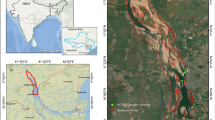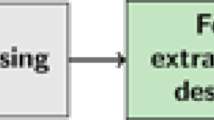Abstract
In the present study an attempt has been made to identify the green vegetation based on colour using visible spectral colour indices such as excess green index (ExG), excess red index (ExR) and excess green minus excess red index (ExGR). At first stage, the performance of colour indices were tested at four illumination intensities using the standard colour patches. The results indicated a clear separation between the ExG, ExR and ExGR values of green colour patches (foliage, yellow green & green) and soil colour patches (dark skin, moderate red & magenta) at illumination intensity of 89.04 ± 8.12 lux than 188.8 ± 6.36, 259.25 ± 12.73 and 359.28 ± 10.10 lux illumination intensities. This observation suggested that the colour indices might perform better at low lighting condition. In the second stage, the images of original plants and soil were captured at an illumination intensity of 89.04 ± 8.12 lux and classification rate at different threshold were studied. The average correct classification rate of ExGR and ExG colour indices were found to be 93.03% and 86.03% at threshold values 0 and 10, respectively. This indicates that the colour index ExGR could be successfully employed for image based classification of plant and non-plant material.











Similar content being viewed by others
References
Adelkhani, A., Beheshti, B., Minaei, S., & Javadikia, P. (2012). Optimization of lighting conditions and camera height for citrus image processing. World Applied Sciences Journal, 18(10), 1435–1442.
Agrawal, K. N., Singh, K., Tiwari, P. S., & Chandra, M. P. (2012). Laser sensor based tractor mounted herbicide applicator. In Proceedings 2012 national conference on agro-informatics and precision agriculture (AIPA), 183–185.
Campbell, J. B. (1996). Introduction to remote sensing. New York: Guilford Press.
Chandel, A. K., Tewari, V. K., Kumar, S. P., Nare, B., & Agarwal, A. (2018). On-the-go position sensing and controller predicated contact-type weed eradicator. Current Science, 114(7), 1485–1494.
Chandler, R. C. (2003). Autonomous agent navigation based on textural analysis (Doctoral dissertation, University of Florida).
El-Faki, M. S., Zhang, N., & Peterson, D. E. (2000). Factors affecting color-based weed detection. Transactions of the ASAE, 43(4), 1001–1009.
Hamuda, E., Glavin, M., & Jones, E. (2016). A survey of image processing techniques for plant extraction and segmentation in the field. Computers and Electronics in Agriculture, 125, 184–199.
Heisel, T., Christensen, S., & Walter, A. M. (1999). Whole-field experiments with site-specific weed management. Precision Agriculture, 99, 759–768.
Kirk, K., Andersen, H. J., Thomsen, A. G., Jørgensen, J. R., & Jørgensen, R. N. (2009). Estimation of leaf area index in cereal crops using red–green images. Biosystems Engineering, 104(3), 308–317.
Mahmud, M. S., Zaman, Q. U., Esau, T. J., Price, G. W., & Prithiviraj, B. (2019). Development of an artificial cloud lighting condition system using machine vision for strawberry powdery mildew disease detection. Computers and Electronics in Agriculture, 158, 219–225.
Meyer, G. E., & Neto, J. C. (2008). Verification of color vegetation indices for automated crop imaging applications. Computers and Electronics in Agriculture, 63(2), 282–293.
Meyer, G. E., Hindman, T. W., & Laksmi, K. (1998). Machine vision detection parameters for plant species identification. In Precision agriculture and biological quality, 3543, 327–335. International Society for Optics and Photonics.
Rasmussen, J., Nørremark, M., & Bibby, B. M. (2007). Assessment of leaf cover and crop soil cover in weed harrowing research using digital images. Weed Research, 47(4), 299–310.
Slaughter, D. C., Giles, D. K., & Downey, D. (2008). Autonomous robotic weed control systems: A review. Computers and Electronics in Agriculture, 61(1), 63–78.
Steward, B. L., & Tian, L. F. (1999). Machine-vision weed density estimation for real-time, outdoor lighting conditions. Transactions of the ASAE, 42(6), 1897.
Suh, H. K., Hofstee, J. W., & van Henten, E. J. (2014). Shadow-resistant segmentation based on illumination invariant image transformation. In Proceedings international conference of agricultural engineering.
Tangwongkit, R., Salokhe, V. M., & Jayasuriya, H. W. (2006). Development of a real-time, variable rate herbicide applicator using machine vision for between-row weeding of sugarcane fields. Agricultural Engineering International: CIGR Journal, 8, 1–12.
Tangwongkit, B., Tangwongkit, R., & Nakashima, H. (2008). Field evaluation of a variable rate herbicide applicator. Agricultural Information Research, 17(1), 1–5.
Thainimit, S., Muangkasem, A., Keinprasit, R., Duangtanoo, T., Tangwongkit, R., & Isshiki, T. (2012). Real-time selective herbicide applicator for field sugarcane. Agriculture and Natural Resources, 46(6), 955–965.
Tian, L. F., & Slaughter, D. C. (1998). Environmentally adaptive segmentation algorithm for outdoor image segmentation. Computers and Electronics in Agriculture, 21(3), 153–168.
Tian, L. F., Slaughter, D. C., & Norris, R. F. (1997). Outdoor field machine vision identification of tomato seedlings for automated weed control. Transactions of ASAE, 40(6), 1761–1768.
Wang, N., Zhang, N., Wei, J., Stoll, Q., & Peterson, D. E. (2007). A real-time, embedded, weed-detection system for use in wheat fields. Biosystems Engineering, 98(3), 276–285.
Yihang, F., Tingting, C., Ruifang, Z., & Xingyu, W. (2014). Automatic recognition of rape seeding emergence stage based on computer vision technology. In 2014 The third international conference on agro-geoinformatics, 1–5. IEEE.
Acknowledgements
The authors thank Director, ICAR-CIAE, Bhopal, for providing the facilities to conduct experiments.
Author information
Authors and Affiliations
Contributions
UK: Conceptualization, Methodology, Data curation, Software, Writing- Original draft preparation. KNA: Conceptualization, Methodology, Reviewing and Editing. NSC: Laboratory facility, Reviewing and Editing. KS: Software, Reviewing and Editing.
Corresponding author
Ethics declarations
Conflict of interest
The authors declare that they have no conflict of interest.
Additional information
Publisher's Note
Springer Nature remains neutral with regard to jurisdictional claims in published maps and institutional affiliations.
Rights and permissions
About this article
Cite this article
Upendar, K., Agrawal, K.N., Chandel, N.S. et al. Greenness identification using visible spectral colour indices for site specific weed management. Plant Physiol. Rep. 26, 179–187 (2021). https://doi.org/10.1007/s40502-020-00562-0
Received:
Accepted:
Published:
Issue Date:
DOI: https://doi.org/10.1007/s40502-020-00562-0




